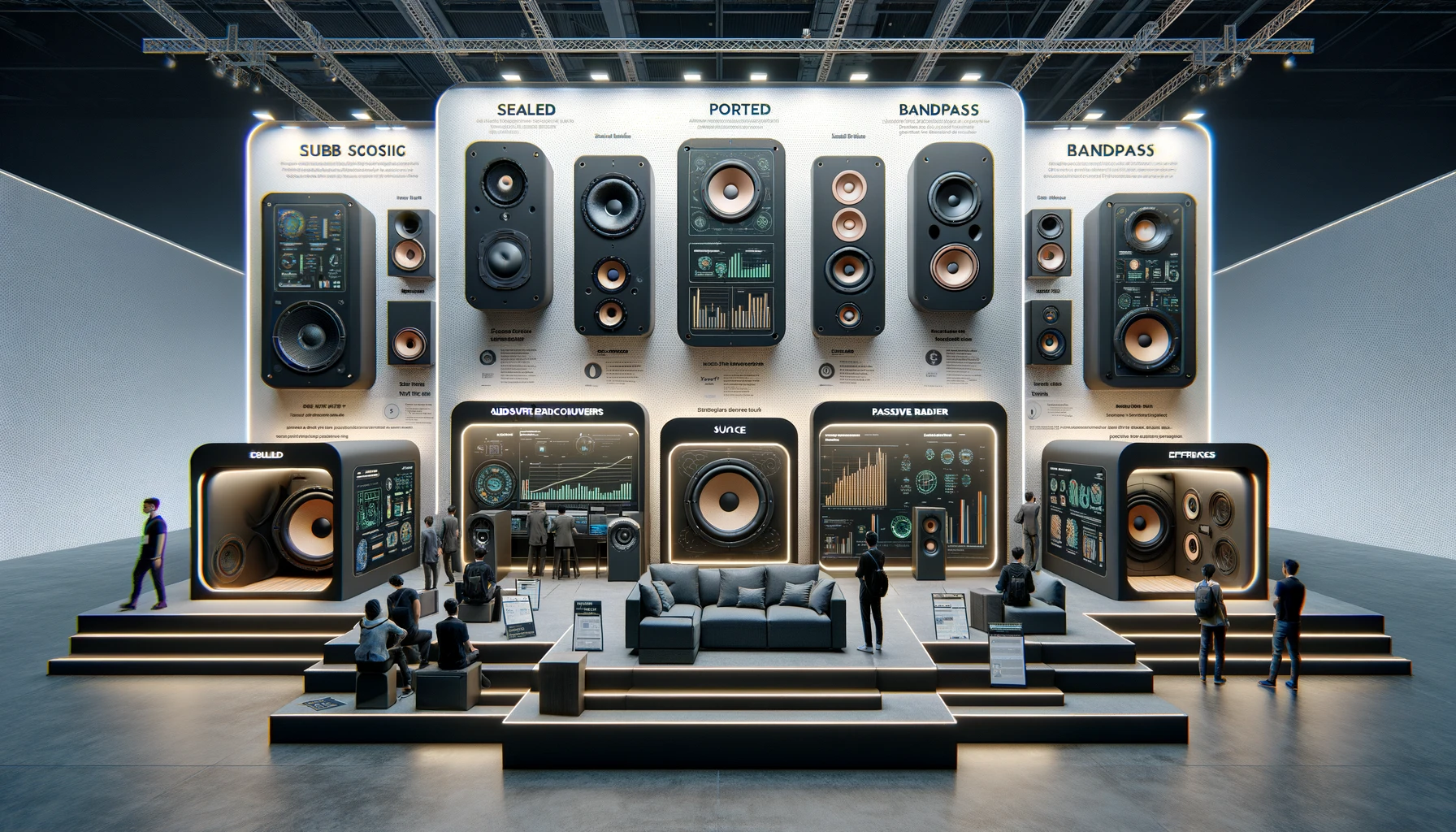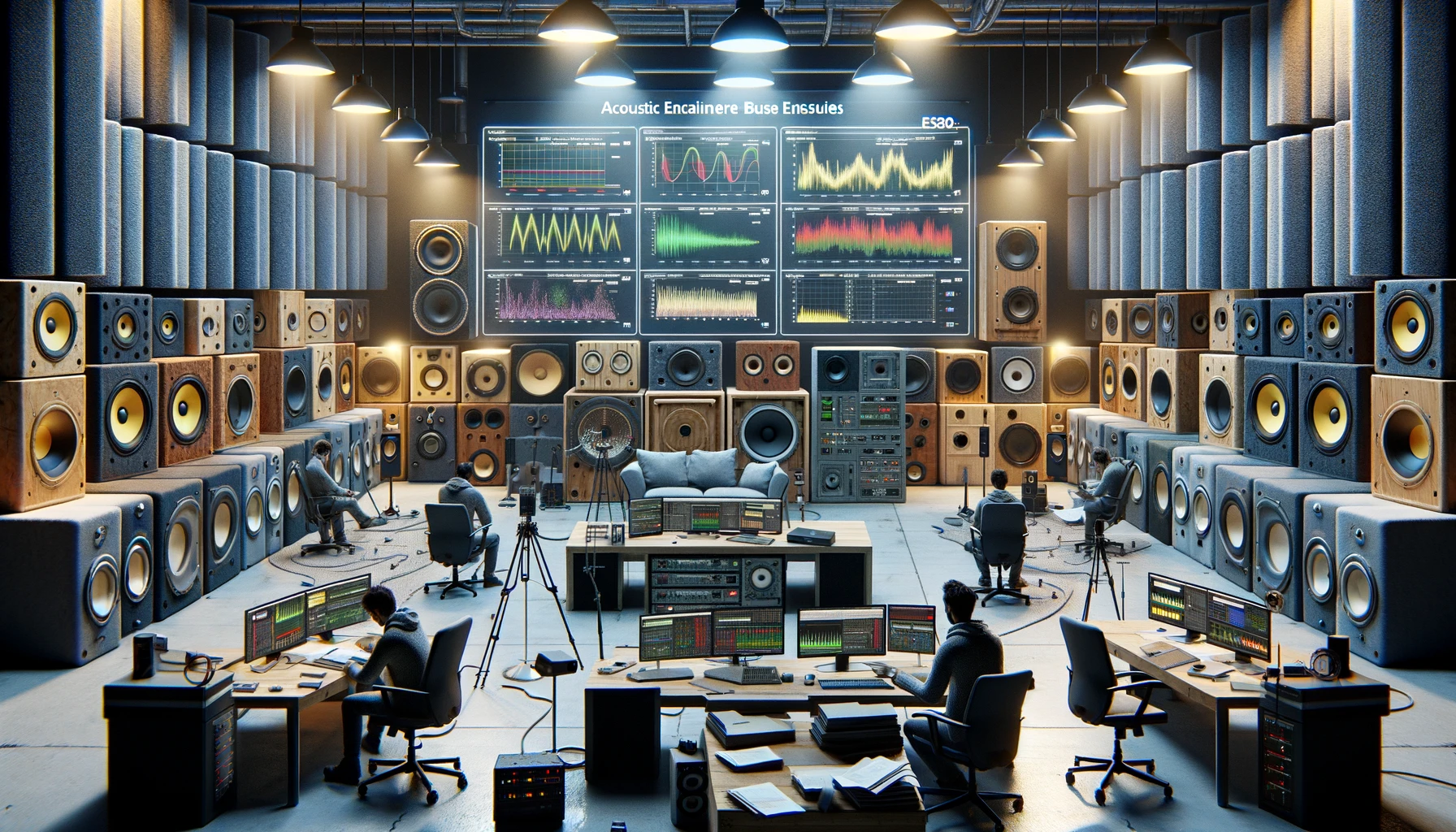Sound quality is very important in audio systems. This applies to cars, homes, and professional setups. One key part that affects sound quality a lot is the type of enclosure that holds the speaker, including the subwoofer.
The type of material and design you choose for an enclosure can really change how deep the bass sounds, the range of frequencies it can produce, and the overall sound quality. In this blog, we will look at the different types of enclosures, the materials used to make them, and the design principles that help create the best sound output.
Elevate your audio experience by exploring the different types of subwoofer enclosures. You can find the best fit for your subwoofer to improve your bass response. By choosing the right enclosure, you can unlock the full power of your sound system. Dive into the options today for better bass performance!
Understanding Different Enclosure Types

When you think about speaker cabinets and enclosures, there are three main types: sealed, ported, and passive radiator enclosure. Each type has a special design and sound features that affect how the sound comes out. It's important to know the different types of speaker cabinets and what makes them unique. This knowledge will help you make good choices about your speaker setup.
Sealed Enclosures
Sealed or acoustic suspension loudspeaker enclosures deliver tight and clear bass. They control sound really well. These sealed designs reduce distortion, which means you get a cleaner sound compared to other types. That's why audiophiles, who want precise sound, prefer sealed enclosures. A sealed enclosure has a quick reaction, which is called transient response. This means the speaker can change quickly with the music. This helps in making the sound clear and accurate. Understanding the enclosure size is important to get the best bass response and sound quality, and it is important to understand how sealed enclosures work.
Another good thing about sealed enclosures is that they keep sound inside. This means they work better because they reduce outside noise. This is especially helpful in car audio systems, where outside sounds can get in the way of the sound output. By keeping the soundwaves contained, sealed enclosures help to improve the audio and provide a better listening experience.
Ported Enclosures
Ported enclosures, sometimes called bass reflex enclosures, have a special port. This port helps improve the bass output of a loudspeaker. The way a ported enclosure works is by using sound waves that come from the tuning frequency, allowing the air mass inside the port to resonate. These waves are related to something called Helmholtz resonance. This setup helps to make bass response better inside the enclosure. It also means that the loudspeaker can use its power more efficiently, leading to louder and deeper bass.
The tuning frequency of a ported enclosure is very important for getting the bass response you want. If you pick the right tuning frequency, the ported enclosure can highlight certain sounds in the low-frequency range. This lets you customize the sound output to fit what you like, making it a good choice for many audio experiences. Still, you should remember that ported enclosures need specific amplifier power. It is essential to choose an amplifier that can properly power the speaker in a ported enclosure setup.
Bandpass Enclosures
Bandpass enclosures help improve bass response by focusing on a specific frequency range, but they are typically not designed for high frequencies. This range is usually between 20 and 200 Hertz. They use a mix of sealed and ported designs. This setup cuts out unwanted sounds while enhancing the frequencies you want. With this design, the speaker works well with the enclosure, which leads to better and more controlled sound output. The resonance frequency characteristics make this design very good for handling sounds below 30 Hertz. Sealed box designs and single-reflex bandpasses control movement better at these low frequencies. This quality helps reduce the risk of damage to the speaker from low-frequency sounds.
The special box design of bandpass enclosures is important for their sound output. When the enclosure is tuned carefully, it helps to boost the bass frequencies in the right range. This tuning improves the bass response, and the line helps with the overall sound quality. It allows for the best sound output within the chosen frequency range.
Understanding cabinet design is very important for the sound output in a bandpass enclosure. When you use the differential tuning of the enclosure, the sound waves can be directed properly. This helps in getting the bass response you want. With this design, the speaker can perform at its best. This leads to a more enjoyable listening experience.
Materials Used in Enclosure Construction

When you look at enclosure materials and their sound qualities, the material you pick for construction matters a lot. It affects how the sound behaves, especially in cutting down on internal reflections. Different materials have different weights, ways they respond to sound, and strengths. These factors can change how sound output is experienced. The next part will discuss three popular materials for enclosures: Medium Density Fiberboard (MDF), plywood, and fiberglass.
Medium Density Fiberboard (MDF)
Medium Density Fiberboard (MDF) is popular for making speaker enclosures. This is because it has good sound properties and is easy to work with. MDF is made from wood fibers mixed with glue and pressed together. This process creates a strong and even material. It helps reduce sound cancellation and resonance. As a result, it improves sound quality.
The sound quality of MDF makes it a great option for building enclosures. Its density helps to fine-tune the enclosure, improving the bass response and frequency range. MDF enclosures have consistent sound properties. This ensures they deliver reliable sound output at different frequencies. They also boost the low frequencies, leading to clearer sound. That's why many professionals choose MDF for audio projects, where it's important to have accurate sound reproduction.
Plywood
Plywood is a material that many people use for making speaker enclosures. It is popular because it is strong and helps control sound better. Plywood is created by stacking thin sheets of wood and gluing them together. This layering makes it strong and long-lasting, making it a good choice for building enclosures, especially when a lot of them are made at one time.
The properties of plywood make it a great option, especially for low frequencies. Its density and structure help improve sound quality and bass response. Plywood controls resonance well. This reduces sound distortion and leads to clearer sound output. Its acoustic features also make plywood good for bracing. This helps make enclosures stronger and lowers resonance inside them.
Different kinds of plywood work well for making speaker enclosures. Hardwood plywood, like birch plywood, is a common choice. This is because it is strong and lasts a long time. Choosing the right type of plywood depends on several things. These include the sound output you want, how much you want to spend, and ease of use. So, it's a popular pick for both DIY makers and people in the audio industry.
Fiberglass
Fiberglass is a special material that is flexible and can be changed to fit your needs. To make a strong but light enclosure, it uses layers of resin and fiberglass matting. This type of structure lets you create unique shapes for the enclosure. You can adjust it to meet certain sound needs.
One big benefit of fiberglass enclosures is their great sound insulation. Fiberglass helps reduce noise, making the sound output clearer by keeping the speaker away from outside noise. Plus, using fiberglass matting and resin can create detailed vent and port designs. This design boosts bass output and improves overall sound quality.
Fiberglass enclosures are strong and firm. This helps to limit the vibrations inside them. The methods used to strengthen fiberglass also add to the strong build of the enclosure. This reduces vibrations and lessens sound distortion. Additionally, fiberglass has good sound qualities. It allows the enclosure’s size to be adjusted to make sure the speaker works well within the frequency range.
Acoustic Comparison of Different Enclosure Materials

Now that we have looked at the different enclosure materials, let’s compare how they perform with sound. This will help us see their effect on sound output. Each type of enclosure material has its own properties. These properties affect frequency response, bass output, and sound quality.
Acoustic Performance of MDF
MDF is great for sound because it reduces distortion and resonance. This leads to better sound quality. Its density and consistent structure help deliver a clear bass response and good sound output. MDF works well at different frequencies, ensuring that you get steady sound quality, especially when compared to other materials.
Using MDF for building enclosures affects how we hear sound. MDF is great for sound because it helps with low frequencies. This means it offers deeper bass and clearer sound. Because of these qualities, MDF is a good choice for getting the sound output you want in speaker systems. This applies to any type of music or audio use.
Acoustic Performance of Plywood
Plywood has a strong build and good control over sound. This helps it perform well with sound quality. The special features of plywood improve sound clarity, especially for low-frequency sounds. Plywood can reduce sound cancellation and resonance. This means it has a frequency response that cuts down on distortion. As a result, it provides a clear and clean sound output.
Plywood enclosures have several benefits. One key advantage is their ability to adjust to the surrounding environment. They do a great job of blocking outside noise. This helps keep the sound clear and enhances the listening experience. Because of this flexibility, plywood enclosures can work well with many audio systems, whether for home theaters or car audio setups.
Acoustic Performance of Fiberglass
Fiberglass enclosures have special features that help with sound. They provide good sound insulation and can be designed in many ways. Using fiberglass in building these enclosures helps lessen sound distortion. This leads to clear and accurate sound output. Fiberglass enclosures also ensure great sound quality by blocking outside noise. This is important in loud places where other sounds can be a problem.
The special qualities of fiberglass help to make the best use of space in speaker enclosures. By designing these enclosures carefully, we can use fiberglass’s strength and ability to control sound to boost how well the speakers work. This makes sure the speakers can perform well within the right frequency range, leading to clearer sound and better output.
Designing Enclosures for Optimal Acoustics

When designing loudspeaker design enclosures, several important factors affect sound quality. You need to calculate the right enclosure volume. This is key for good sound. Also, choose the right shape of the enclosure. This should match the sound preferences for your loudspeaker system.
Calculating Enclosure Volume for Sound Quality
Calculating the right volume for an enclosure is very important for good sound quality, especially for bass response. The volume affects the tuning frequency, which helps get the frequency response you want. If you calculate the enclosure volume correctly, you can get a better transient response. This leads to nicer sound quality.
One important type of design is the sealed enclosure for bass drivers. The size inside the enclosure is very important for its sound quality. By carefully figuring out the internal volume of the enclosure, we can improve the bass response. A proper size allows the sealed enclosure to produce a clear and sharp bass output. This makes it great for many audio uses.
Choosing the Right Enclosure Shape for Sound Preference
The shape of the enclosure plays a big role in how good the sound is, especially considering the internal dimensions. Different shapes can change how sound waves act. This can affect the frequency response and the overall sound quality, mainly at higher frequencies. When picking the right enclosure shape, you should think about what sound you like and the sound qualities you want. Here are some important points to keep in mind:
- Choose the enclosure design based on what kind of sound you like. This can be a strong bass response, a balanced sound, or focus on certain frequency ranges.
- The shape of the enclosure has an effect on how sound resonates, cancels, and interferes within it. This can change the sound output.
- Different shapes of enclosures might need different tuning methods to get the sound output you want.
- The shape of the enclosure also helps it adapt to the environment. This means the sound output will stay steady, no matter where you listen.
- It's important to know how enclosure shape affects resonance, cancellation, and soundwaves. This knowledge helps you pick the best design according to your sound preference.
Principles of Enclosure Design for Better Acoustics
When designing loudspeaker driver speaker enclosures, there are some important principles to keep in mind for better sound quality. First, you need to understand the frequency range of the speakers. Second, consider the power needs of the amplifier. Lastly, think about the transient response of the speaker system.
Acoustic Principles to Consider
When designing speaker enclosures, you need to think about several acoustic principles. These are important to make the sound output better. Here are some basic principles to remember:
- Frequency range: It is important to know the speaker's frequency range. This helps in creating a box that achieves the right sound output, especially for low frequencies.
- Amplifier power needs: Every type of enclosure and material needs different amp power. Keeping this in mind helps the speaker work best in the given enclosure volume.
- Transient response: The transient response shows how fast the speaker reacts to audio changes. Improving this response helps create better sound quality and accuracy.
Measuring and Calculating Box Dimensions for Acoustic Efficiency
Measuring and calculating the size of speaker boxes is very important for good sound quality. When measurements are accurate, the box can be designed to meet the right impedance curve and frequency response, including considerations for mechanical damping. This also helps in figuring out the tuning frequency needed for the best sound output. Paying attention to detail in measuring and calculating helps get the acoustic properties needed for great sound.
The design of the vent or port is important when creating the box size. The vent allows sound waves to pass through, affecting the bass response and overall sound output. A well-designed vent can improve the bass response of the speaker. This helps to reduce distortion and boost acoustic efficiency. Therefore, paying attention to both the vent design and box dimensions is key to getting the best sound output from the speaker enclosure.
How to Choose Between Different Enclosure Types and Materials?
Choosing the right type of enclosure and material can be tough. There are several things to think about. You should consider your sound preferences. Also, think about how the enclosure material affects the sound quality. Let’s examine these factors more closely.
Considering Your Sound Preferences
When picking an enclosure type and material, it's important to think about sound preference. Each type and material makes different sounds. Choosing the one that fits your sound likes can really improve your listening experience.
- Sealed enclosures made with MDF are a good choice for people who love clear sound.
- These enclosures make tight and accurate bass.
- They also have controlled sound properties that help improve sound quality.
- Ported enclosures focus more on delivering bass output.
- This type might be better for those wanting stronger low-frequency sounds.
- Bandpass enclosures can filter out unwanted sounds.
- They focus on a certain range, which can be good for specific audio setups.
When you think about how enclosure materials affect sound, remember that each material has its own acoustic traits. These traits can change the frequency response, bass output, and overall sound quality. By considering sound preferences when you choose the enclosure type and material, you create a personalized audio experience that fits your likes and the needs of your audio system.
How Does the Material of the Enclosure Impact the Acoustic Output?
The type of material used for the enclosure plays a big role in how sound comes from the speaker system. Different materials feel and sound different because of their own unique properties. These materials influence how sound resonates and how strong the structure is. Let's look at how the enclosure material can change the way sound comes out.
- The material used for the enclosure affects how sound waves behave. This changes the frequency response, bass output, and overall sound quality. Each material has different acoustic properties.
- Choosing the right enclosure material also affects how the enclosure is designed and tuned. Different materials may need different sizes, vent designs, and tuning frequencies to get the best sound output.
- Knowing the acoustic properties of the enclosure material helps in making smart choices about design, shape, and volume. This results in improved sound quality.
- For example, MDF is dense and consistent. This helps with sound clarity and precise bass response. Plywood controls resonance and provides a cleaner sound. Fiberglass offers better sound quality by isolating the speaker from the surrounding sound.
- By looking at how the enclosure material's acoustic properties match sound preferences, audio fans can make good decisions about which materials to use for their speaker systems.
Protection from Environmental Factors
Protection from environmental factors is important for keeping speaker enclosures working well and lasting longer. When used outside, enclosures are exposed to moisture, heat, and UV rays. These elements can harm the materials and sound quality. Waterproofing is especially necessary for outdoor setups. Rain can seriously damage the enclosure. To prevent this, proper sealing and protective coatings should be used. This helps keep the enclosure materials strong and effective for a long time.
Humidity can make wood materials, like MDF and plywood, warp. This can change the sound quality and create unwanted vibrations. To solve this, you can use materials that resist weather changes better or add protective treatments. This can really improve how long the enclosure lasts and how it works. It’s important to know these tips if you want to buy a speaker system that will last and work well in different situations.
Ensuring Durability Against Elements
When designing and choosing speaker enclosures, it is important to think about how durable they are against the environment. Different materials, like MDF, plywood, and fiberglass, each have their own strengths.
- MDF is great for sound, but it does not resist moisture well. This makes it harder to use outside unless it is treated.
- Plywood, especially if it comes from high-quality hardwoods, is stronger in different weather. Its layered makeup helps it handle moisture better.
Fiberglass enclosures are strong and can take on tough outdoor conditions. They are light but also very durable. A fiberglass enclosure can even survive being outside for a long time without much damage. Adding coatings or sealants can make them last even longer. These steps help keep the enclosures looking good and working well over time. Choosing the best material and protection will really help the speaker system last longer and work better.
It's also important to think about the design of the enclosure. This includes where the vents are placed and how it is supported inside. These factors can affect how well it holds up against environmental challenges. A well-designed enclosure can help improve sound quality. It also makes the system stronger. This ensures that it performs well in different conditions.
Innovations in Enclosure Design
Innovations in speaker design and enclosures have really improved. Now, we get better sound quality and stronger products. Modern tools like computer-aided design (CAD) and 3D printing help in making detailed models of unique enclosure shapes. This way, they can boost sound quality while using less material. These new methods allow designers to create enclosures that fit their speaker drivers and sound needs perfectly. This makes the listening experience much better.
Rapid prototyping methods have changed how we make enclosures. They allow quick changes and tests of different designs. This helps designers improve their ideas based on real-life sound performance data. As a result, we see better sound output and increased enclosure efficiency. By using these new methods, audio experts can build enclosures that work well and are strong enough for different environments. This helps make speaker systems more durable and reliable.
The recent focus on sustainability has changed how we design enclosures. Now, we are using eco-friendly materials and methods to make them. This change helps the environment and meets the customer demand for sustainable audio options. As we keep innovating in enclosure design, we can look forward to improvements that will boost performance and care for the environment in the audio industry.
Advancements in Rapid Prototyping for Enclosures
Advancements in quick prototyping for enclosures have greatly changed the audio industry. They make design processes faster and more efficient. For example, 3D printing lets designers make accurate models of speaker enclosures much quicker than older manufacturing methods. This fast feedback cycle helps audio engineers test and improve designs before starting large-scale production. This way, the final product will meet sound quality standards.
One main benefit of rapid prototyping is that it helps test different materials and shapes. This way, engineers can create better designs for enclosures. They can try out several sizes and forms to find what works best for sound quality and performance. This quick process is great when dealing with high manufacturing volumes. It lets them make exact changes quickly without spending a lot of money or waiting for long periods.
Advancements in software modeling tools allow designers to test how designs will work with sound waves before making prototypes. This helps them understand how different designs affect sound. It speeds up the development process and improves the chance of creating loudspeaker enclosures that have great sound quality. As rapid prototyping keeps advancing, it will become even more important for future loudspeaker enclosure design. This will help audio systems meet the high expectations of users.
Conclusion
In conclusion, it is important to know the different types of enclosures and the materials used to build them for good sound. Sealed enclosures give clear and accurate sound. Ported enclosures help to boost bass response. Bandpass enclosures mix the advantages of both types.
For materials, medium-density fiberboard (MDF) is popular because it is strong and helps control sound. Plywood gives a warmer and more natural sound. Fiberglass is very strong and can resist vibrations well.
You should also think about the size and shape of the enclosure to match your sound preferences. The material used for the enclosure can affect the sound quality a lot. So, pick the best one to achieve the sound you want.
Improving Subwoofer Performance: The Importance of Enclosures
- A subwoofer needs a good enclosure to work well.
- The right box can help the sound be clearer and stronger.
- A sealed enclosure offers tight bass and accuracy.
- A ported enclosure provides a louder sound and more bass.
- Both types can boost how the subwoofer plays low frequencies.
- Choosing the right enclosure can make a big difference in sound quality.
The Future of Sound: New Trends in Subwoofer Enclosures
- Subwoofer enclosures are changing in exciting ways.
- New designs help improve sound quality.
- Many people want enclosures that look great and work well.
- Companies are using different materials for better sound.
- Compact enclosures save space while keeping good sound.
- Smart technology is being added for more features.
- Trends show a focus on eco-friendly materials.
- Many enclosures now come with adjustable features for users.




